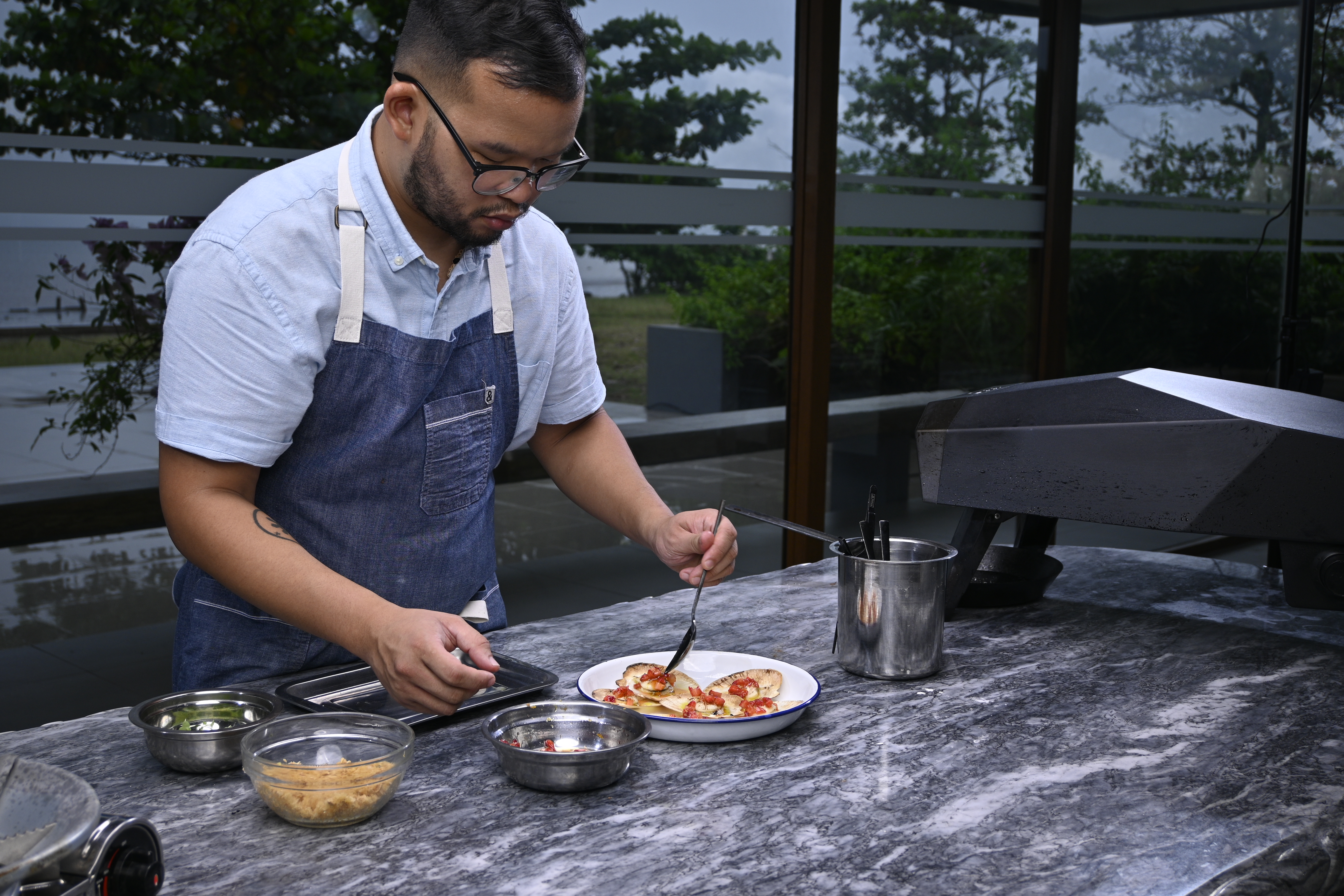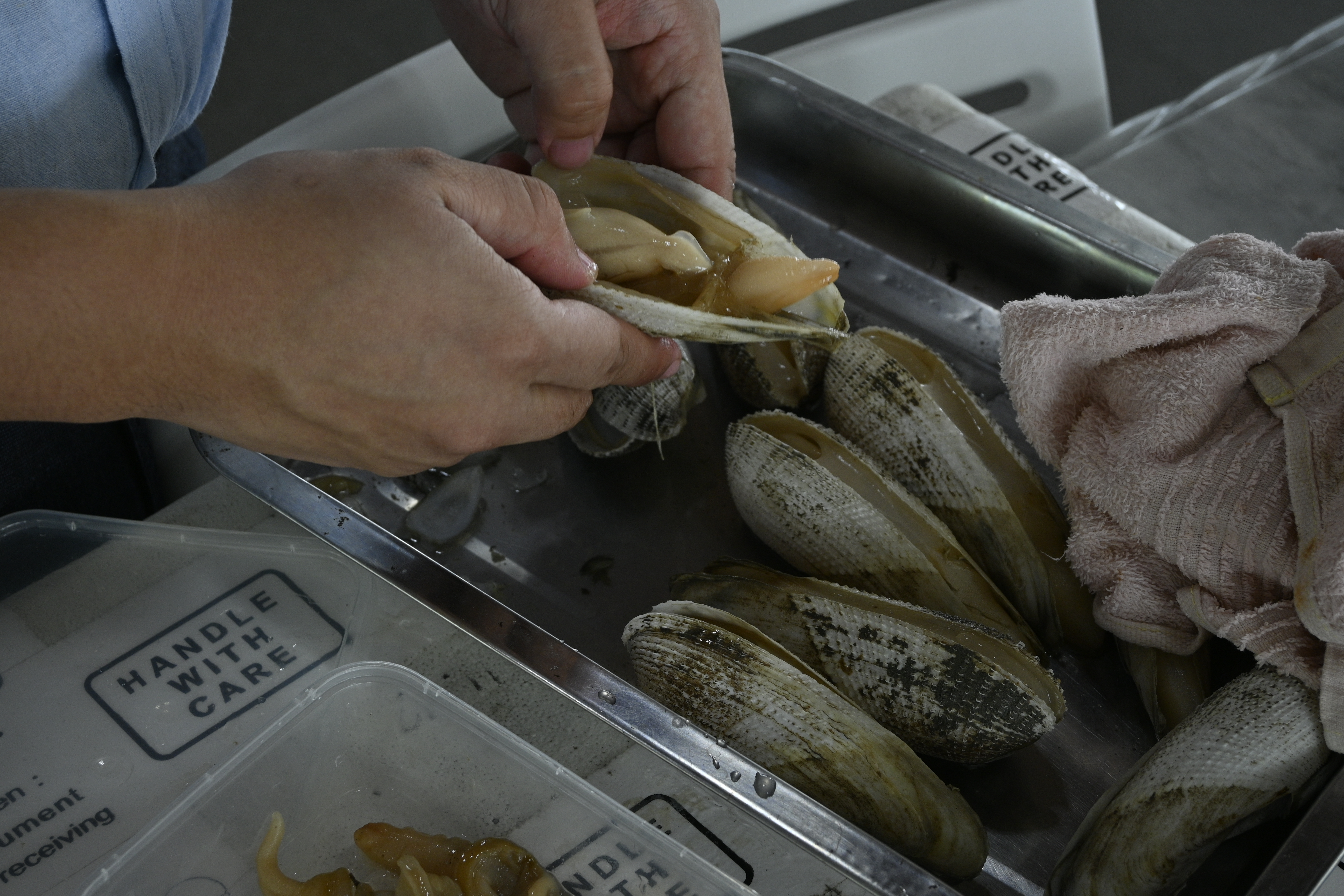Editor's Note: The writer, Chaela Ruth Mirano, is a features story producer.
Local prawns with fresh and fermented green tomatoes, prawn sauce, garlic pureé, and sunflower sprouts
When people think of Negros, three things tend to come to mind—sugar, seafood, and smiles. As Negrenses, this trifecta is the foundation of our culture and is woven into the thread of our daily lives. It should be no mystery that here, the most popular dishes involve seafood; whether it’s preparing milkfish for dinner or slurping oysters by the beach, seafood brings us tight-knit Negrenses even closer together. Just ask Chef Gabriel Melocoton, an emerging talent in the culinary world.
During one of my first conversations with him, he talked bright-eyed about food’s unique ability to gather people from all walks of life and create a shared, meaningful experience. He also expressed his respect for provenance, a term used to describe the origins of food, such as where it has been grown, raised, or caught.
Inspired by the plentiful sea and local restaurants, Chef Gabriel Melocoton creates a dinner menu that spotlights three kinds of shellfish found in Negros.
Eager to learn about Chef Gabriel’s own roots, I asked about his childhood and early memories linked to food. Recalling his frequent time at his family-owned fish farm in Himamaylan, he said, “As a child, I loved spending time there because it was like an adventure to me. Every harvest season, I enjoyed waking up at either 4 am or earlier to accompany my dad. My young brain was so transfixed by the process of harvesting prawns and milkfish.”
“These people, the farmhands, were all so incredibly knowledgeable about their catch. As I grew older and had more mentors in the culinary world, I realized how important it is to talk to the people who grow, catch, and harvest our food.”
Chef Gabriel started his career at 21 years old by studying at Enderun Colleges in Manila and then attending pastry school at the William Angliss Institute in Melbourne, Australia. In his earlier years, he worked at esteemed establishments, such as the Michelin-starred Michael Mina restaurant in San Francisco, California.
Roasted scallops with strawberry relish, lemon crumb, and pak choi.
After a few years abroad, Chef Gabriel is enthusiastic to be back in Negros, where he can source virtually all the ingredients he needs within a few kilometers of wherever he’s cooking. In nearly every town in every city here, there’s a wet market that abounds with a variety of seafood, including prized catches, such as litog (scallops), lukon (local prawns), and diwal (angel wing clams).
Setting up kitchen at a private resort in Talisay, Chef Gabriel took these three kinds of shellfish and created a modern, fresh-forward menu that we got to enjoy together.
Roasted scallops with strawberry relish, lemon crumb, and pak choi
Scallops are sweet, delicate, and juicy clams. They are predominantly found in Northern Negros in the coastal waters of Cadiz, Sagay, Escalante, and the nearby islands in their jurisdiction. Grilled scallops are usually served in seafood restaurants, topped with melted cheese.
With the backdrop of the sea, Chef Gabriel highlighted the fresh and plump scallops by preparing them with strawberry relish (diced strawberries dressed in a light vinaigrette) and a dash of pak choi (a type of Chinese cabbage) to showcase and elevate their natural beauty and taste. To add a textural component to the dish, Chef Gabriel created a lemon crumb using bread crumbs, toasted nuts, and lemon zest.
Chef Gabriel prepares a romantic seafood dinner for himself and partner Chaela Ruth Mirano.
Local prawns with fresh and fermented green tomatoes, prawn sauce, garlic pureé, and sunflower sprouts
A prawn's mild and sweet flavor makes it extremely versatile to pair with a variety of ingredients. They are generally found and cultured in ponds all over the island. Negros is actually the top prawn producer in the country, with at least 500 hectares dedicated to prawn production. Traditionally, local prawns are used for sinigang na hipon (a type of sour Filipino soup), or simply steamed and lathered with local vinegar or garlic butter.
For his version, Chef Gabriel used every part of the prawn to demonstrate that one of the best ways to respect ingredients is to not waste them. The prawn meat was cooked and used as the main component of the dish, while the head and shells were grounded into a paste and used as the base for the sauce.
Beer battered diwal with green onion powder and preserved dalandan (sweet orange) aioli
Also known as Angel Wings Clam because of how its shells look when fully opened, the diwal is a highly seasonal shellfish in the Philippines, prized for its delectable and succulent taste. In Hiligaynon, diwal literally means “sticking out the tongue.” This shellfish thrives in the sandy-muddy bottoms of intertidal areas in the coastal waters of Iloilo, Capiz, and Negros Occidental, particularly Valladolid and Pulupandan. Negrenses enjoy eating diwal either grilled, cooked as laswa, a vegetable soup, or baked with cheese and garlic.
To open the diwal, pry open the shell with a knife, slice the meat inside, and then wash it with water to remove the sand.
As diwal is only available for a few months a year, Chef Gabriel wanted to emphasize the importance of cooking in season. This allows him to have the very best produce in optimum condition. Using unique components, such as green onion powder made from dehydrated green onion tops, and preserved dalandan aioli (fermented dalandan mixed into a mayonnaise base) that complement the now-crunchy diwal, this dish is a hyper-local take on a crowd favorite at pubs.
These three dishes are proof that Chef Gabriel approaches new recipes like a puzzle. During his Research and Development (R&D) process, he always asks himself repeatedly, “What is this dish missing? What works and what doesn't? What can I do to elevate this?" His process is long, tedious, and methodical but no less creative.
Since every region in the country has its own flair, Chef Gabriel takes advantage of local seafood and seasonal ingredients to create a plethora of tastes and flavors that pay homage to his home—Negros.
Text By: Chaela Ruth Mirano
Photo and Video By: Bakunawa Films
Design and Architecture
Cultural Experience
Art and Craft
Food
People
BAO
-

Negros Season of Culture

Rooted. Taking on the World.
A global messaging system that promotes the cultural assets of Negros as shaped by its rich heritage and traditions, the unique identity of the place, and the talent of its people.
Popular Posts

Dinagsa Festival
Sunday, January 07, 2024

Chicken Ubad with Monggo (Chicken with Banana Pith and Mung Beans)
Thursday, July 15, 2021
Linutik
Friday, August 27, 2021
Rooted. Taking on the World.
Negros Season of Culture is a global messaging system that promotes the cultural assets of Negros as shaped by its rich heritage and traditions, the unique identity of the place, and the talent of its people.
Search This Site
Quick Links
People
Design and Architecture
Upcoming Events
Art and Craft
BAO
Food
Menu Footer Widget
Rooted. Taking on the World.
A global messaging system that promotes the cultural assets of Negros as shaped by its rich heritage and traditions, the unique identity of the place, and the talent of its people.
Search This Site
Upcoming Events
 Negros Season of Culture Celebrates National Heritage Month
Negros Season of Culture Celebrates National Heritage Month
The Negros Season of Culture Celebrates National Heritage Month this... Negros Season of Culture joins the National Commission on Culture and the Arts in celebrating National Heritage Month
Negros Season of Culture joins the National Commission on Culture and the Arts in celebrating National Heritage Month
Negros Season of Culture joins the National Commission on Culture...
Menu Footer Widget
• Copyright © -2021
- Negros Season of Culture








